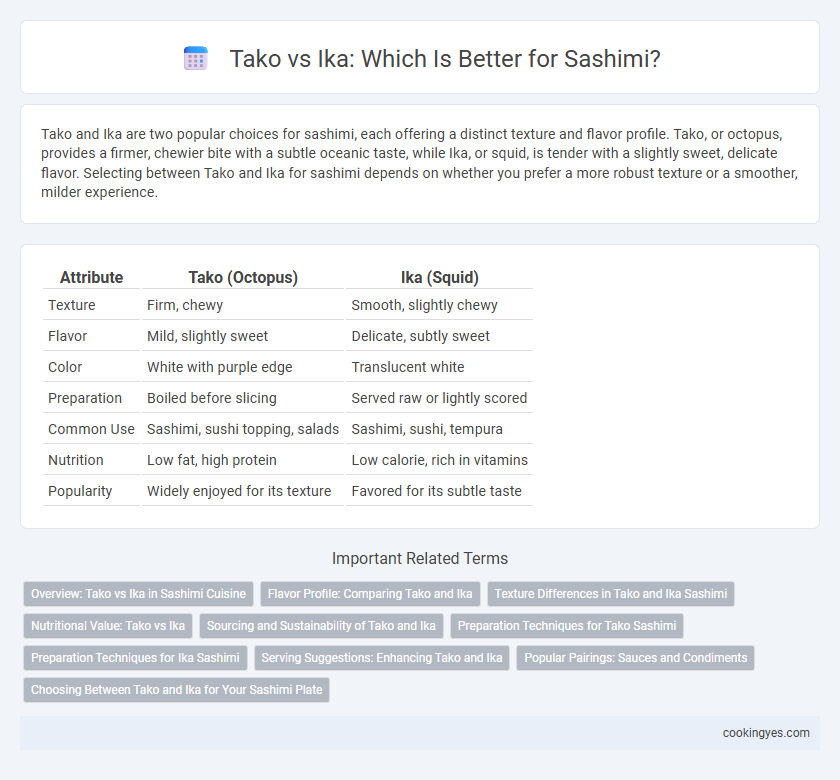Tako and Ika are two popular choices for sashimi, each offering a distinct texture and flavor profile. Tako, or octopus, provides a firmer, chewier bite with a subtle oceanic taste, while Ika, or squid, is tender with a slightly sweet, delicate flavor. Selecting between Tako and Ika for sashimi depends on whether you prefer a more robust texture or a smoother, milder experience.
Table of Comparison
| Attribute | Tako (Octopus) | Ika (Squid) |
|---|---|---|
| Texture | Firm, chewy | Smooth, slightly chewy |
| Flavor | Mild, slightly sweet | Delicate, subtly sweet |
| Color | White with purple edge | Translucent white |
| Preparation | Boiled before slicing | Served raw or lightly scored |
| Common Use | Sashimi, sushi topping, salads | Sashimi, sushi, tempura |
| Nutrition | Low fat, high protein | Low calorie, rich in vitamins |
| Popularity | Widely enjoyed for its texture | Favored for its subtle taste |
Overview: Tako vs Ika in Sashimi Cuisine
Tako and Ika are two popular seafood choices in sashimi cuisine, each offering distinct textures and flavors. Tako, derived from octopus, has a firm and chewy texture with a mild, slightly sweet taste, while Ika, or squid, features a tender and slightly sweet profile with a smoother bite. Both are prized for their freshness and are often paired with soy sauce and wasabi to enhance their subtle oceanic flavors.
Flavor Profile: Comparing Tako and Ika
Tako sashimi offers a chewy texture with a mildly sweet and briny flavor that intensifies when dipped in soy sauce, providing a satisfying bite distinct from other seafood. Ika sashimi features a smoother, slightly crunchy texture with a delicate, subtly sweet taste that highlights its freshness and pairs excellently with ponzu sauce or a touch of wasabi. The flavor profile of Tako is more pronounced and savory, while Ika presents a lighter, cleaner taste ideal for those preferring a more delicate sashimi experience.
Texture Differences in Tako and Ika Sashimi
Tako sashimi, made from octopus, features a firm, slightly chewy texture that requires careful slicing to balance tenderness and bite. Ika sashimi, derived from squid, presents a smoother, more delicate texture with a subtle sweetness, offering a softer chew compared to tako. The contrast in texture between tako's resilient firmness and ika's gentle silkiness defines their unique sashimi experiences.
Nutritional Value: Tako vs Ika
Tako (octopus) sashimi offers higher protein content with approximately 29 grams per 100 grams, supporting muscle growth and repair. Ika (squid) sashimi provides a lower calorie count around 92 kcal per 100 grams, making it a lighter option with essential minerals like copper and selenium. Both tako and ika deliver beneficial nutrients, but tako is preferable for protein intake while ika suits low-calorie, mineral-rich diets.
Sourcing and Sustainability of Tako and Ika
Tako (octopus) for sashimi is often sourced from wild fisheries in Japan and Korea, with sustainability concerns due to overfishing and habitat impact, prompting a shift toward regulated harvesting and aquaculture development. Ika (squid) is primarily wild-caught in the North Pacific and Mediterranean regions, benefiting from more sustainable fishery management practices and faster reproduction rates, making it a more eco-friendly choice for sashimi. Consumers increasingly prefer Ika for sashimi to support sustainable seafood sourcing and reduce pressure on overexploited Tako populations.
Preparation Techniques for Tako Sashimi
Tako sashimi preparation involves carefully boiling octopus tentacles briefly to achieve the right texture, followed by immediate chilling to enhance tenderness and flavor. Skilled slicing techniques are essential to cut thin, even pieces that accentuate the firm yet tender bite unique to tako. Unlike ika sashimi, which is served raw, tako requires precise heat application and rapid cooling to balance chewiness while preserving freshness.
Preparation Techniques for Ika Sashimi
Ika sashimi requires precise preparation techniques, including careful washing and scoring of the squid's flesh to enhance texture and appearance. Expert chefs often remove the skin and use gentle slicing methods to create tender, thin pieces that maximize flavor absorption. Proper chilling and hydration are essential to maintain Ika's signature chewy yet delicate consistency in sashimi presentations.
Serving Suggestions: Enhancing Tako and Ika
Tako and Ika sashimi are best served thinly sliced to highlight their unique textures--tako offering a firm, slightly chewy bite while ika delivers a tender, smooth experience. Enhancing tako with a touch of yuzu kosho or a sprinkle of sea salt accentuates its natural brininess, whereas ika pairs well with a drizzle of ponzu sauce or a light wasabi soy dip to complement its subtle sweetness. Fresh shiso leaves and finely grated ginger serve as ideal garnishes that elevate the flavors without overpowering the delicate taste of either sashimi.
Popular Pairings: Sauces and Condiments
Tako sashimi, made from octopus, pairs exceptionally well with ponzu sauce and grated ginger, enhancing its chewy texture and subtle sweetness. Ika sashimi, derived from squid, is often served with soy sauce and wasabi to complement its tender, slightly sweet flavor. Both types of sashimi are frequently accompanied by pickled ginger and shiso leaves to balance and elevate their distinct tastes.
Choosing Between Tako and Ika for Your Sashimi Plate
Tako (octopus) offers a firm, slightly chewy texture with a mild, sweet flavor, making it ideal for those who enjoy a more substantial bite in their sashimi. Ika (squid) features a tender, slightly slippery texture and a subtle sweetness that pairs well with soy sauce and wasabi. When choosing between Tako and Ika, consider texture preference and flavor intensity to create a balanced sashimi plate that complements other seafood selections.
Tako vs Ika for Sashimi Infographic

 cookingyes.com
cookingyes.com